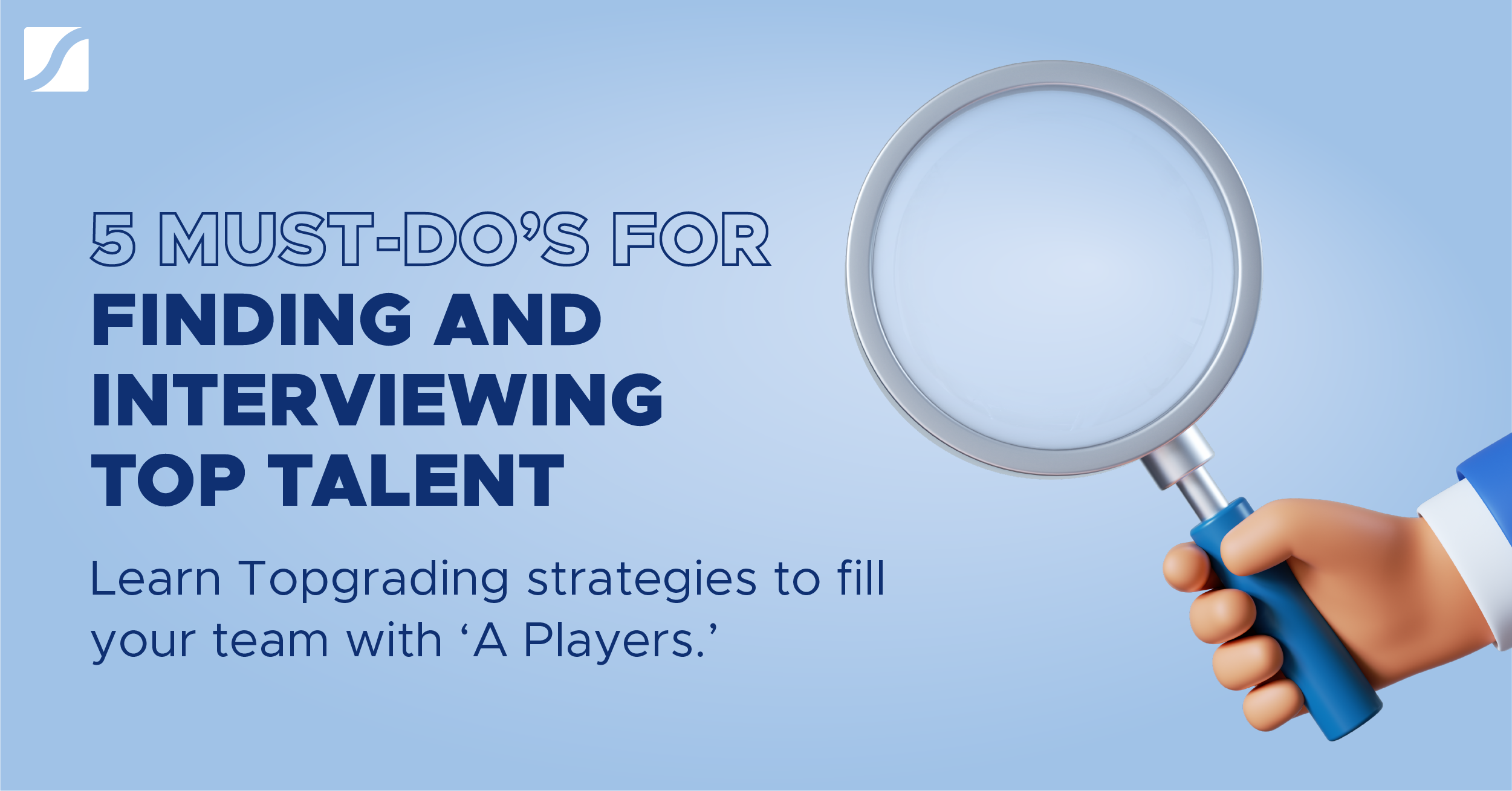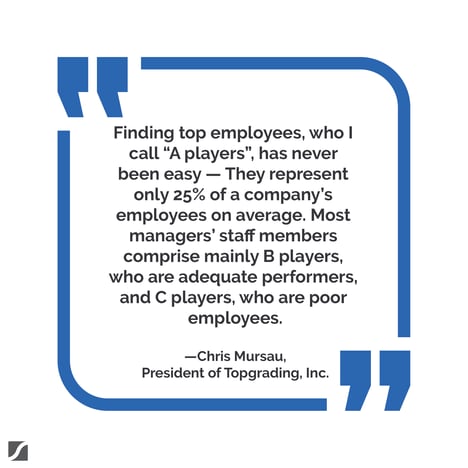5 Must-Do’s For Finding And Interviewing Top Talent

As the world sees the never-ending headlines about the talent shortage wreaking havoc for companies around the globe, business leaders are living the reality: Finding cream-of-the-crop employees seems to become more challenging a day.
That’s bad news, but let’s be honest: Finding those top employees, who I call “A players,” has never been easy. That’s why the recruiting, hiring, and retention experts I work with as the president of Topgrading Inc. have found that only 25 percent of a company’s employees, on average, are A players.
A Players are employees in the top 10 percent of talent available for the role you’re filling and the salary you’re offering. The goal is to stack your team with these A Players. Unfortunately, most managers’ staff members comprise mainly B players, who are adequate performers, and C players, who are poor employees.
That means most hires are mis-hires. And that’s problematic for a number of reasons, not the least of which is that it costs your business time and money. Dr. Brad Smart, founder and CEO of Topgrading, wrote about these costs in his book Topgrading: How Leading Companies Win By Hiring, Coaching, And Keeping The Best People. For each mid-manager you hire who’s not an A player, according to one example, your financial loss equals 15 times their base salary, and your time loss equals 200 hours.
But there’s a way to fill your workforce with A Players, and it starts with implementing a hiring process that’s as structured as the other processes in your business. That structured process should include an interview that asks specific questions aimed at collecting the valuable information that helps you find A Players.
5 Topgrading Techniques To Find Top-Performing Talent
The secret to hiring talent that meets A Player criteria lies in 5 key techniques—including the biggest item, which I’ve already mentioned. So, let’s start our list of 5 techniques with that one:

1. Follow A Structured Process
Ask yourself what your company’s hiring process is. Is it a structured process that hiring managers can repeat whenever they have an opening? Is it as strong as the other processes in your organization?
If not, beef it up by developing a standard set of practices, including those I’ll mention here, to use when filling each open position.
2. Establish Criteria For A-Players
The first step in a structured Topgrading hiring process is to be clear about the type of employee you’re seeking. The traditional process for hiring often starts with a quickly thrown-together job description, perhaps using a template copied and pasted from the Internet.
But starting with a detailed inventory of requirements and measures of success for the specific role you’re filling helps you identify just the right candidates. It also sets expectations for performance from Day One.
3. Gather Reliable Information
There’s a reason author and philosopher Stanley J. Randall said, “The closest to perfection a person ever comes is when he fills out a job application form.” Resumes, CVs, and LinkedIn profiles are really just sales brochures.
Get to the facts by using what I call the Topgrading Truth Motivator: Let your candidates know from the outset that they’ll be responsible for arranging reference calls with their managers. High performers will welcome the opportunity. Low performers will remove their names from consideration.
4. Conduct Revealing Interviews
Spending a half-hour to an hour with a candidate doesn’t allow you the opportunity to connect with them in a meaningful way. A Topgrading interview generally lasts 90 minutes for recent graduates and 3 to 4 hours for executives. That’s because Topgrading interviews don’t rely on the typical line of questioning that elicits just one example of a skill or behavior and moves on.
Get a clearer understanding of what your candidate brings to the table by conducting a chronological interview that delves into their experiences starting with their teen years.

Topgrading Interview Questions That Reveal A-Players
Working in tandem with a partner in the interview, ask the following 14 questions. Start with the candidate’s education, and work your way through each step of their experiences. Wrap up with a discussion about the candidate’s plans and goals.
Questions About Education
Topgrading interviews start with 5 to 7 minutes of questions that go all the way back to age 14 to 18, or high school years in the United States. Aim for multiple examples of experiences, abilities, and lessons learned by asking the following questions:
- What were the high points?
- What were the low points?
- What work experiences did you have?
- Who did you consider to be influential people?
- What were your thoughts as you moved to the next phase in your life?
Then move on to college or university experiences, asking the same set of 5 questions and following up on points discussed as appropriate.
Questions About Work History
Now it’s time for the part of your discussion that should take up about 75 percent of the interview time: work history. Again, go back to the beginning, with high-level questions about all jobs the candidate has had and more-specific questions about recent roles.
Questions About All Past Jobs
Ask the finalist to address the following high-level questions about each of their past jobs, starting by focusing on the first job and then moving chronologically through subsequent roles. Questions to ask about all jobs include:
- What were your responsibilities?
- What were your successes and accomplishments?
- What mistakes did you make, and what would you do differently?
- What will your manager say about you?
- Why did you leave? Or, how did your responsibilities change in your next role?
Questions About Recent Jobs
When discussing jobs the candidate has had within the past decade, you should also include more detailed questions. In addition to the high-level questions, ask the following regarding each role:
- Tell me about the organization.
- What shape was that organization, department, or role like when you arrived? And when you left?
- What did you like and dislike?
- Who was your manager? What were their strengths, weaknesses, and management style?
Then wrap up your interview with 5 to 10 minutes of talking about the candidate’s career goals.
5. Ensure Solid Verification
The last key technique in the Topgrading hiring process is where the rubber meets the road in your Topgrading Truth Motivator. Ask your candidates to reach out to their past managers to arrange a 15 minute-call for you to verify the information the candidate provided in their interview.
Once the candidate has paved the way for the discussion, you’re more likely to quickly reach their managers—and get the verification you need to shape your hiring decision.
Learn And Practice The Topgrading Techniques
The Topgrading process for recruiting and hiring employees is different from the usual steps that businesses take to find talent, and you likely will find interviewing to be a challenge at first.
But if outcomes of businesses that already use the Topgrading approach are any indication, it will be worth your effort to master the techniques. For those companies, their hiring practices landed them A Players about 26 percent of the time before they used Topgrading. After implementing Topgrading techniques, their A Player-hiring success rate jumped to about 85 percent.
If you’re ready to work toward mastering the Topgrading process—and filling your team with A Players, despite today’s hiring challenges—you can start by digging into these resources:
- The replay of my recent Growth Institute webinar “The Right Talent Wins,” with information about the Topgrading Master Business Course and an outline of course objectives
- The Topgrading ebook, with details about the Topgrading process such as how to calculate the cost of your mis-hires and how to track your hiring success


